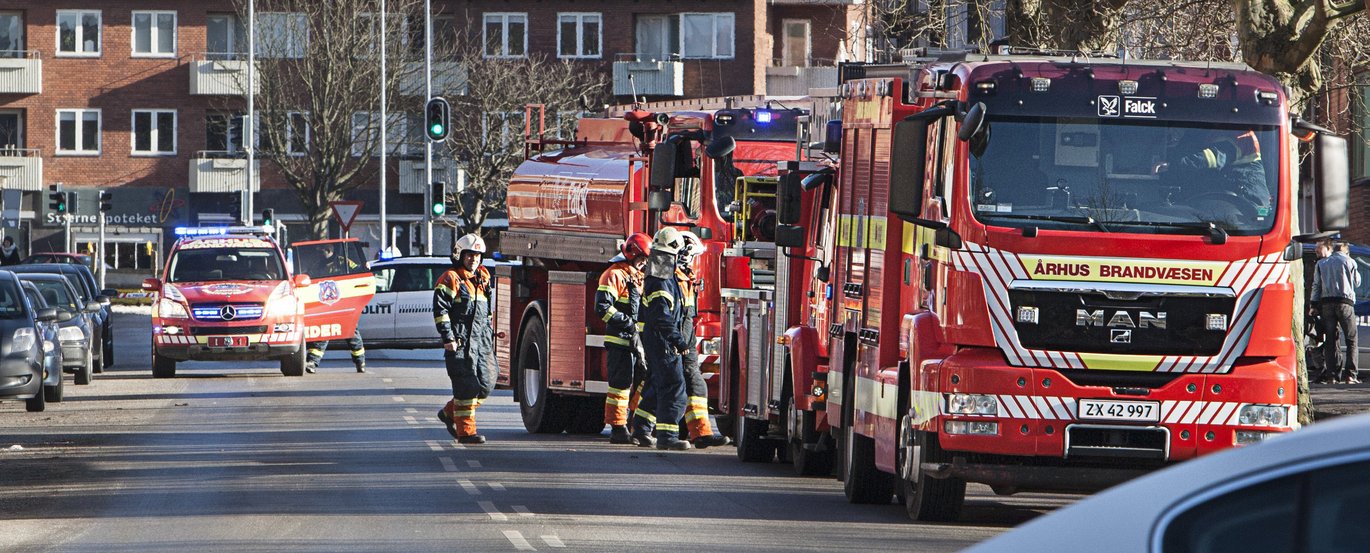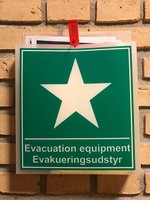All units at AU must hold annual evacuation drills
A threat to Malmö University on Monday 8 January shut down the university. Aarhus University has received three threats in the past five years. In response, the university has intensified its focus on emergency preparedness and response. Most recently, the senior management team instructed all units to hold annual evacuation drills.

Be prepared
- Make sure you know the signal for evacuation in the AU locations where you spend most of your time. Types of signals include voice alarms systems, warning bells or even other employees in yellow or orange vests knocking on the door of your office or classroom and asking you to vacate the building.
- Read the alarm and evacuation instructions in your building. These instructions are available at clearly marked locations in all AU buildings.

- Familiarise yourself with the beredskab.au.dk website, where you will find lots of information on what to do in emergency situations involving fires, accidents, acts of violence, bomb threats, suspicious mail, abandoned items and IT system failure.
- Ask your teacher or manager about any special instructions for your unit.
- On the local level, it’s important that new students and employees are informed about the alarm and evacuation instructions.
- AU Evacuate: AU has developed an evacuation app called AU Evacuate. The app is being tested, and currently only works at AU’s Fuglesangs Allé locations. The app warns users in case of evacuation. It also contains emergency response information which is relevant for all students and employees at AU. You can download the app from App Store or Google Play. The app is currently only available in Danish.
What should you do in case of an emergency?
- Follow the instructions you receive from emergency response officers, the police or the fire brigade.
What should you do if there is a fire, an accident or another type of emergency situation?
- Stop the accident if you can do so without putting yourself at risk.
- Call 112
- Evacuate if necessary
- Call the Aarhus University emergency phone number: 87 15 16 17
On Monday 8 January, all students and employees at Malmö University were asked to work from home: the previous week, the university had received a serious threat by email which specifically targeted 8 January. The university’s executive management elected not to release specific details on the nature of the threat. And on Tuesday, students and employees were back at the university, although still under increased security. And the university’s executive management will now evaluate the university’s emergency response in light of the incident.
Evacuation – practice makes perfect
AU’s management has faced similar threat situations several times. In October 2012, Aarhus BSS (then located at Fuglesangs Allé) received a bomb threat which fortunately turned out to be just a scare. On 17 December of the same year, a student phoned in a second bomb threat against Aarhus BSS on Fuglesangs Allé – which also turned out to be baseless. And on 4 March 2013, one of AU’s units on Tåsingegade received a threatening letter.
Most recently, the senior management team discussed AU’s emergency response setup last autumn, although not in response to a specific incident, emphasises Anders Kragh Moestrup, AU’s emergency response coordinator.
“In this connection, the management decided that all units must hold evacuation drills once a year,” he explains.
In the past two years, the number of annual evacuation drills at AU has increased to approximately 40, against no more than five annually in previous years.
“We have many different activities at AU, and we are particularly focused on high-risk locations, such as laboratory animal facilities, laboratories with radioactive material, chemical storerooms and high traffic areas,” says Moestrup.
Anti-terror safeguards
AU’s emergency response plan addresses threats from fire, accidents, threats, suspicious objects and acts of violence, including shooting incidents and terrorism.
READ MORE: Call 112 - then 87 15 16 17
PET (the Danish Security Intelligence Service) assesses that the terror threat against Denmark is ‘serious’. For this reason, AU has focused increasingly on anti-terrorism safeguards in recent years, confirms Moestrup:
“We’ve tightened up our procedures in recent years, particularly in relation to large events with many participants.”
This includes the Regatta and Denmark’s largest Friday bar, annual events which bring thousands of students together in the University Park. For example, by police orders, the roads leading into the University Park were blocked off by massive concrete blocks and transport lorries when the Regatta was held last summer.
And in connection with major international conferences such as MatchPoints, the university has made security material available for use in auditoriums to brief guests who are not familiar with the university on security procedures.
No metal detectors and security checks
While metal detectors and security checks are business as usual at some American universities, there are no plans to introduce these kinds of measures at AU, Moestrup states.
“Our international guests in particular sometimes find it surprising that there’s not more security at AU,” says Moestrup. However, he explains,
“there’s a balance between creating a sense of security without frightening the university’s students and employees. AU’s emergency response setup is there to make people feel safe and secure. As a student or employee at the university, you should feel certain that your safety is a high priority and that there are procedures to ensure that the university is a safe place to be. And according to our assessment, more formal security checks aren’t necessary to introduce into daily operations, and they would actually contribute to making students and employees feel less safe in their daily lives,” says Moestrup.
Different security levels at AU
Another goal of the university’s approach to emergency response is to harmonise security procedures across the university, while taking into account variations in the risk assessments for individual units. But because the security level varies from building to building, some of AU’s locations might feel safer than others nonetheless.
“This is due to the fact that the security certifications which regulate the security level in a building are valid from the moment they come into effect until the end of time. So for example, the security level that applies to the buildings where AU took up occupancy in the 30s is not the same as in new buildings, which are legally required to have voice alarm systems,” explains Moestrup,
who also adds that the university hasn’t installed voice alarm systems in all of its buildings because it would be extremely expensive and not equally relevant in all locations.
He emphasises that all buildings are in compliance with applicable legislation, and that voice alarm systems have been installed in several of the older buildings which are occupied by a lot of people on a daily basis.
Threats against AU – and the only school shooting in Denmark
5 April 1994: The only school shooting in Denmark took place at Aarhus University. A 35-year-old male student shot and killed two students and wounded two students before shooting himself.
26 October 2012: Bomb threat against Aarhus BSS at Fuglesangs Allé in Aarhus. 2,000 students and staff were evacuated, and several exams were cancelled. But it turned out to be a false alarm. No arrests were made.
17 December 2012: Bomb threat against Aarhus BSS at Fuglesangs Allé in Aarhus. Once again the students and staff were evacuated and exams were cancelled before the police determined that it was another false alarm. Three students were charged, and the District Court of Aarhus sentenced one of them to 30 days’ conditional imprisonment and 40 hours of community service, while another received 20 days’ conditional imprisonment and 30 hours of community service. The third student was acquitted. The public prosecutor appealed against the convictions. But the judges in the High Court ruled to uphold the sentences handed down to the two students who had been convicted in the municipal court, while the third student, who had been acquitted in the municipal court, was sentenced to 20 days' conditional imprisonment by the High Court.
4 March 2013: Threatening letter targeting one of AU’s units on Tåsingegade. This turned out to be a false alarm, but not before several roads had been closed and a number of buildings had been evacuated. One person was arrested and charged, but there was insufficient evidence to lead to a conviction.
Translated by Lenore Messick

